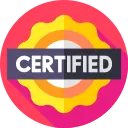FREE
daily Instructor: Dr. Alex HannaCourse Overview
Mastering Live Video Production Workflows
Understanding Production Roles & Responsibilities
- Defining and differentiating the roles of a Director, Technical Director (TD), Audio Engineer, Graphics Operator, Camera Operators, and Stage Manager in a livestream production.
- Implementing clear communication protocols and cueing systems within the production team to ensure seamless transitions and avoid errors.
- Applying strategies for effective pre-production meetings to define goals, assign tasks, and resolve potential issues before the live broadcast.
Building a Scalable Production Infrastructure
- Designing a flexible video routing system using SDI or NDI infrastructure to manage multiple camera sources, graphics, and playback devices.
- Implementing redundancy strategies for critical components like cameras, switchers, and streaming encoders to minimize the risk of broadcast interruptions. For example, setting up automatic failover systems using backup power supplies and redundant network connections.
- Optimizing network configurations for low latency and high bandwidth to ensure smooth video and audio transmission during the livestream.
Advanced Camera Techniques & Visual Storytelling
Camera Operation Techniques
- Applying techniques for achieving optimal focus, exposure, and white balance in various lighting conditions using professional broadcast cameras.
- Mastering camera movements such as pans, tilts, zooms, and pedestals to create visually engaging shots. For example, smoothly executing a zoom-in to emphasize a speaker's expression.
- Using framing and composition techniques like the rule of thirds, leading lines, and depth of field to enhance the visual impact of your shots.
Advanced Shot Composition & Sequencing
- Understanding the principles of visual storytelling and applying them to create compelling narratives through camera shots and sequences.
- Developing a visual vocabulary for different types of shots, including establishing shots, medium shots, close-ups, and cutaways, and knowing when to use each effectively.
- Creating dynamic camera sequences by varying shot types and camera angles to maintain viewer engagement and highlight key moments in the broadcast. For instance, transitioning from a wide shot of the stage to a close-up of a performer's hands during a musical performance.
Audio Engineering & Sound Design for Livestreams
Microphone Techniques & Audio Routing
- Selecting appropriate microphone types (dynamic, condenser, lavalier) for different sound sources and environments.
- Implementing proper microphone placement techniques to minimize noise and maximize audio clarity. For example, using shock mounts and pop filters to reduce unwanted vibrations and plosives.
- Routing audio signals efficiently through a digital audio mixer, applying gain staging techniques to optimize signal levels and prevent clipping or distortion.
Audio Mixing & Mastering Techniques
- Using EQ, compression, and other audio processing tools to shape and enhance the sound of individual audio sources.
- Creating a balanced audio mix by adjusting levels, panning, and equalization to create a clear and engaging listening experience for viewers.
- Mastering the final audio mix to optimize loudness and dynamic range for different playback platforms, such as streaming services and broadcast television.
Graphics & Visual Effects Integration
Creating Dynamic Lower Thirds & Overlays
- Designing visually appealing lower thirds and overlays using graphics software like Adobe After Effects or Motion Graphics templates.
- Integrating real-time data feeds into graphics to display dynamic information such as scores, statistics, and social media feeds.
- Using animation and motion graphics to enhance the visual impact of lower thirds and overlays, creating a more engaging viewing experience.
Incorporating Visual Effects & Transitions
- Utilizing visual effects plugins and techniques to enhance the look and feel of your livestream productions.
- Designing custom transitions to create seamless and visually interesting transitions between camera shots and graphics.
- Implementing green screen technology to composite virtual backgrounds and create immersive environments for your broadcasts.
Live Streaming Platforms & Encoding Techniques
Configuring Streaming Encoders
- Configuring hardware and software encoders such as OBS Studio, Wirecast, and vMix to optimize video and audio encoding settings for different streaming platforms.
- Understanding the impact of different video codecs (H.264, H.265) and audio codecs (AAC, MP3) on stream quality and bandwidth usage.
- Setting appropriate bitrate, resolution, and frame rate settings based on the target platform and audience's internet bandwidth.
Streaming to Multiple Platforms Simultaneously
- Utilizing multi-streaming services like Restream.io and StreamYard to broadcast your livestream to multiple platforms simultaneously, including YouTube, Facebook, and Twitch.
- Configuring streaming endpoints and authentication credentials for each platform to ensure a seamless multi-streaming experience.
- Optimizing streaming settings for each platform to ensure optimal video and audio quality for each audience.
FlashCards
External Resources
Add-On Features
Expert Instructor
Get live study sessions from experts
Honorary Certification
Receive a certificate before completing the course.
Currency
Sign in to change your currency
I'm not ready to enroll?
Tell us why, because it matters.
Enroll With a Key
Course Benefits
Get a Job
Use your certificate to stand out and secure new job opportunities.
Earn More
Prove your skills to secure promotions and strengthen your case for higher pay
Learn a Skill
Build knowledge that stays with you and works in real life.
Lead Teams
Use your certificate to earn leadership roles and invitations to industry events.
Visa Support
Use your certificate as proof of skills to support work visa and immigration applications.
Work on Big Projects
Use your certificate to qualify for government projects, enterprise contracts, and tenders requiring formal credentials.
Win Partnerships
Use your certified expertise to attract investors, get grants, and form partnerships.
Join Networks
Use your certificate to qualify for professional associations, advisory boards, and consulting opportunities.
Stand Out Professionally
Share your certificate on LinkedIn, add it to your CV, portfolio, job applications, or professional documents.
Discussion Forum
Join the discussion!
No comments yet. Sign in to share your thoughts and connect with fellow learners.
Frequently Asked Questions
For detailed information about our Livestream Production & Broadcasting Certification course, including what you’ll learn and course objectives, please visit the "About This Course" section on this page.
The course is online, but you can select Networking Events at enrollment to meet people in person. This feature may not always be available.
We don’t have a physical office because the course is fully online. However, we partner with training providers worldwide to offer in-person sessions. You can arrange this by contacting us first and selecting features like Networking Events or Expert Instructors when enrolling.
Contact us to arrange one.
This course is accredited by Govur University, and we also offer accreditation to organizations and businesses through Govur Accreditation. For more information, visit our Accreditation Page.
Dr. Alex Hanna is the official representative for the Livestream Production & Broadcasting Certification course and is responsible for reviewing and scoring exam submissions. If you'd like guidance from a live instructor, you can select that option during enrollment.
The course doesn't have a fixed duration. It has 23 questions, and each question takes about 5 to 30 minutes to answer. You’ll receive your certificate once you’ve successfully answered most of the questions. Learn more here.
The course is always available, so you can start at any time that works for you!
We partner with various organizations to curate and select the best networking events, webinars, and instructor Q&A sessions throughout the year. You’ll receive more information about these opportunities when you enroll. This feature may not always be available.
You will receive a Certificate of Excellence when you score 75% or higher in the course, showing that you have learned about the course.
An Honorary Certificate allows you to receive a Certificate of Commitment right after enrolling, even if you haven’t finished the course. It’s ideal for busy professionals who need certification quickly but plan to complete the course later.
The price is based on your enrollment duration and selected features. Discounts increase with more days and features. You can also choose from plans for bundled options.
Choose a duration that fits your schedule. You can enroll for up to 180 days at a time.
No, you won't. Once you earn your certificate, you retain access to it and the completed exercises for life, even after your subscription expires. However, to take new exercises, you'll need to re-enroll if your subscription has run out.
To verify a certificate, visit the Verify Certificate page on our website and enter the 12-digit certificate ID. You can then confirm the authenticity of the certificate and review details such as the enrollment date, completed exercises, and their corresponding levels and scores.
Can't find answers to your questions?
Certification Guide

Complete the Course
Begin the course by selecting your experience level in the course content section:
Beginner: Master the material with interactive questions and enough time.
Intermediate: Get certified faster with hints and balanced questions.
Advanced: Challenge yourself with more questions and less time

Earn Your Certificate
To download and share your certificate, you must achieve a combined score of at least 75% on all questions answered.





